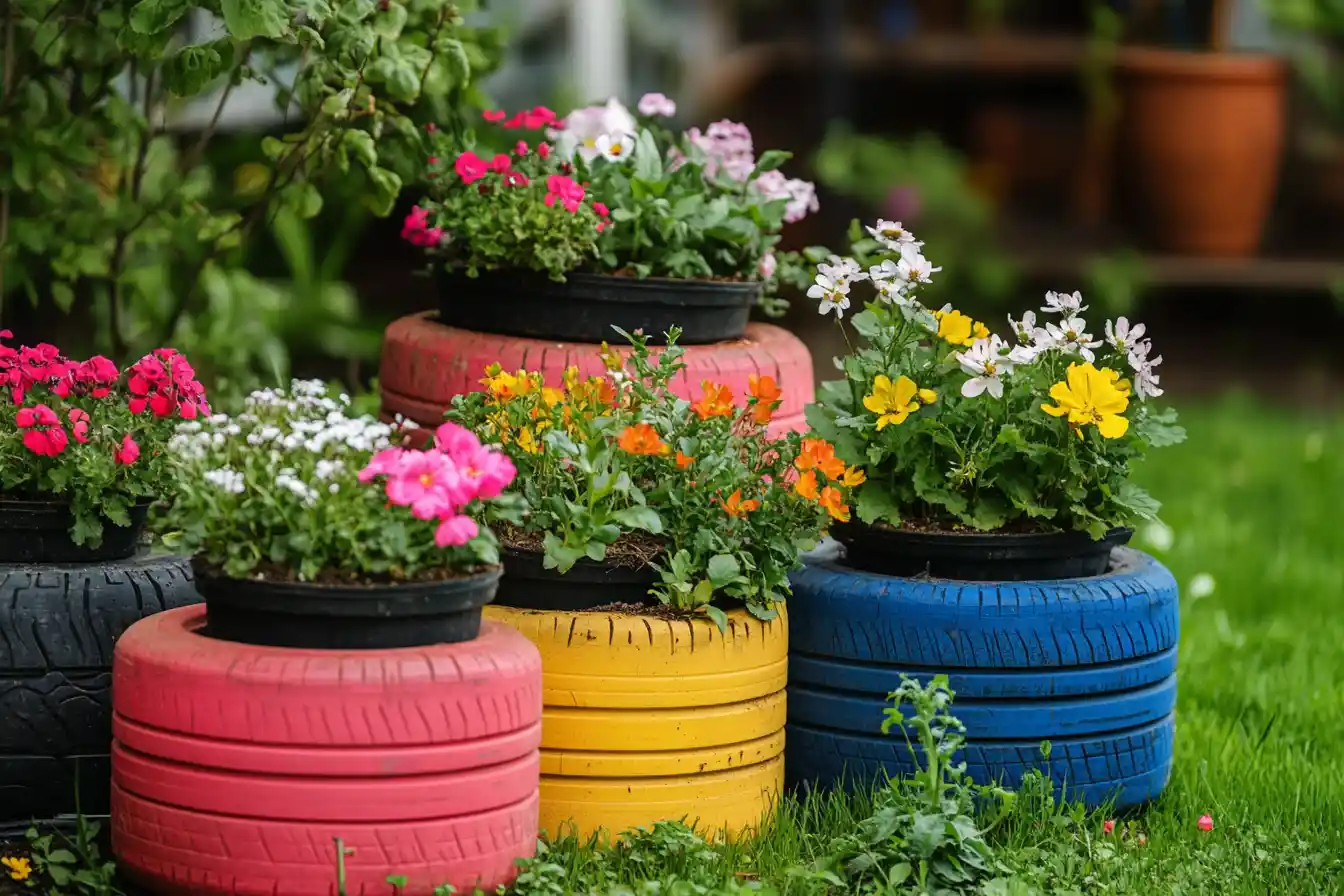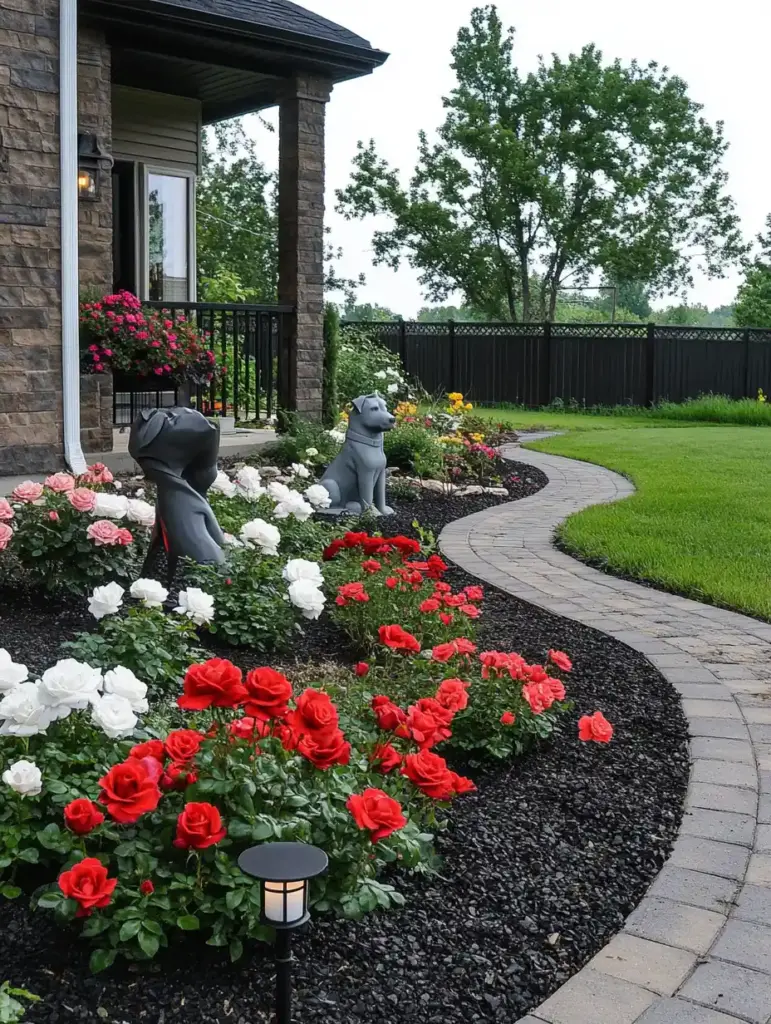A thoughtfully designed flower bed can instantly boost your home’s curb appeal, transforming any entrance into a vibrant, welcoming showcase of color and texture. Whether your front yard is expansive or cozy, the right combination of layout, plant selection, and structure can turn even the smallest patch into a stunning floral focal point.
In this guide, we’ll explore 15 creative flower bed ideas to elevate your landscape using approachable design techniques and beautiful, low-maintenance plants. These styles suit all experience levels and home types—from charming cottage gardens to sleek, modern spaces.
Let’s dig into the possibilities!
Table of Contents
15 Easy Flower Bed Ideas to Beautify Your Front Yard
1. Walkway Flower Bed
A flower bed that flanks your walkway does more than just fill space—it creates a guided, fragrant path that welcomes guests to your home. Strategically placed along sidewalks or front paths, this style of bed draws the eye and offers a sensory experience with every step.
To make the most impact:
- Use fragrant flowers like lavender, jasmine, or miniature roses near entry points.
- Choose a mix of heights—taller blooms at the back, low-growing ground covers near the edge.
- Add definition with natural edging: cobblestones, bricks, or decorative borders keep the bed tidy and help prevent soil runoff.
Pro tip: Include lighting along the walkway to highlight your flower bed’s beauty even after sunset.
2. Colorful Flower Wall

Short on space? A flower wall offers a creative vertical twist on the classic flower bed, turning fences, exterior walls, or trellises into vibrant living tapestries. This idea is perfect for compact front yards or urban homes where ground space is limited but style is not.
To design your own flower wall:
- Use climbing plants like clematis, bougainvillea, or wisteria to add cascading color.
- Incorporate hanging planters or wall-mounted pots filled with lobelia, nasturtium, or trailing fuchsia.
- For structure, anchor your display with a wooden trellis, metal grid, or reclaimed pallet for a rustic feel.
Don’t forget to match plant choices with your sun exposure and watering needs. A well-placed vertical flower bed can become the highlight of your home’s facade.
3. Circular Flower Bed with Centerpiece
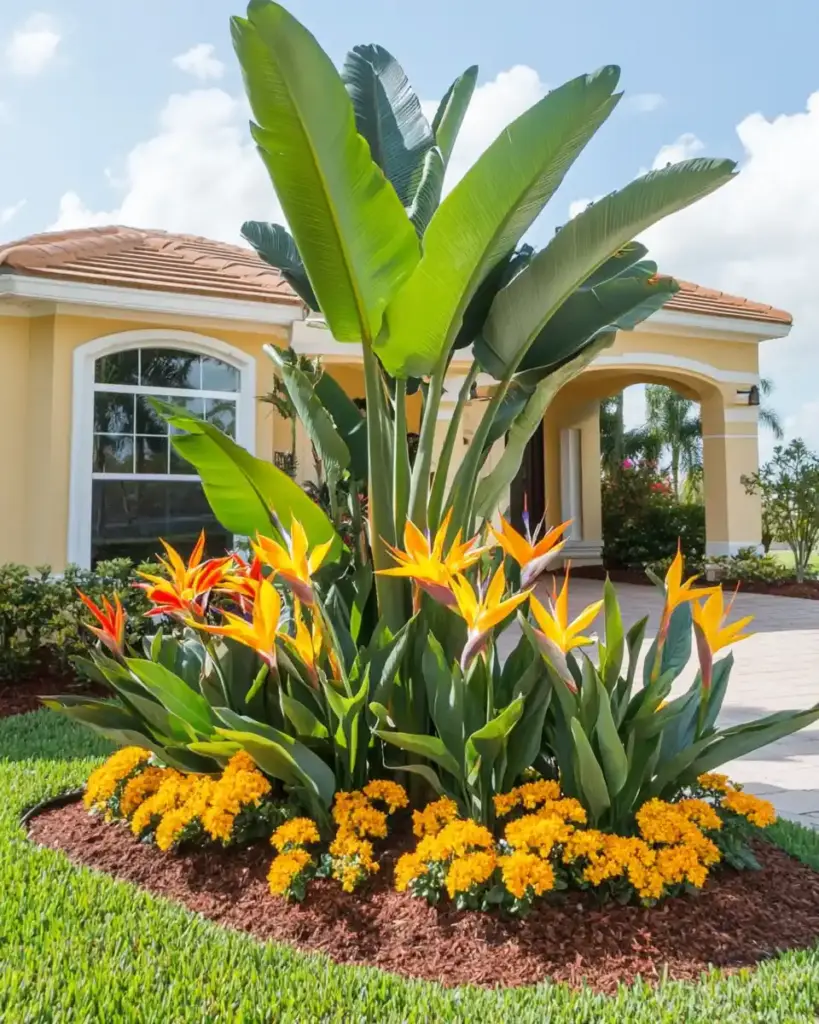
A circular flower bed adds a touch of symmetry and sophistication to your front yard. By placing a striking centerpiece at the core, you create a focal point that naturally draws the eye and organizes the surrounding space.
Ideal centerpiece options include:
- A dwarf flowering tree or ornamental grass
- A small garden fountain or birdbath
- A sculpture or decorative garden feature
Design tips:
- Use concentric planting: place taller flowers or shrubs near the center and shorter ones toward the outer ring.
- For a more relaxed look, scatter plants in an asymmetrical layout using native perennials or wildflowers.
- Border the edge with rocks, bricks, or low-growing border plants to maintain shape and style.
This flower bed layout works beautifully on lawns, near driveways, or as a standalone garden statement.
4. Raised Flower Bed with Seating
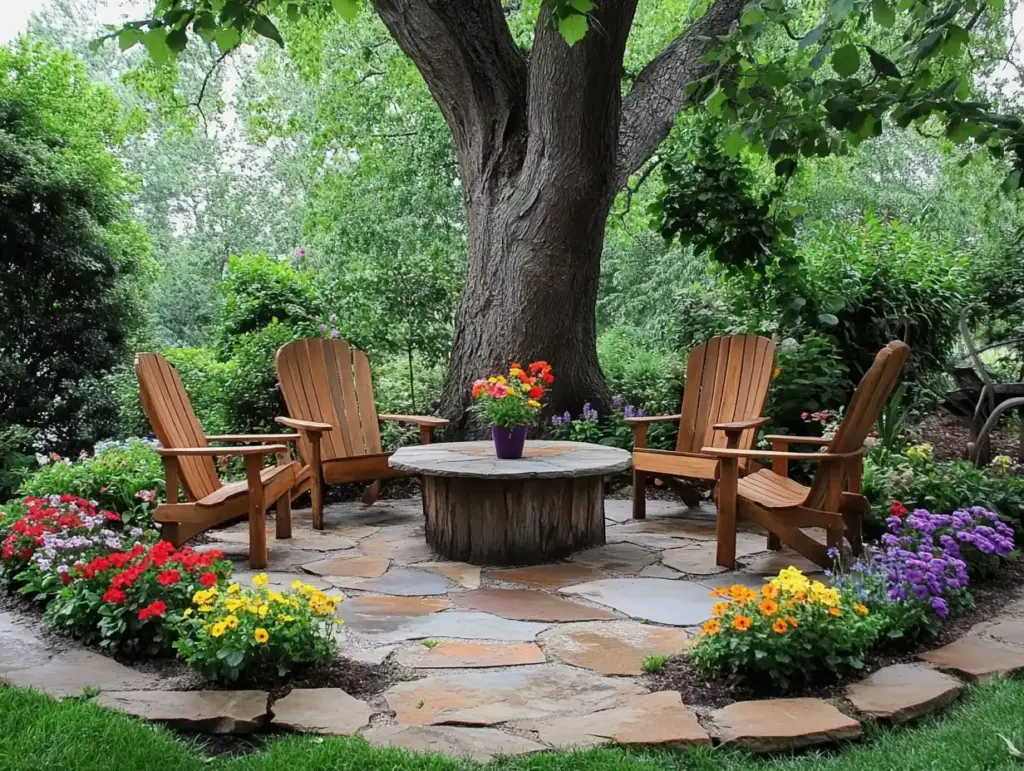
Merge form and function with a raised flower bed that includes built-in or adjacent seating. This smart design not only enhances your home’s aesthetics but also offers a cozy spot to relax and enjoy your front yard garden.
Construction ideas:
- Use materials like natural stone, brick, or reclaimed wood for the raised bed frame.
- Incorporate a bench along the edge or integrate built-in seating directly into the structure.
- Design the height to be comfortable for sitting—typically 18–24 inches.
Planting tips:
- Use a mix of cascading blooms, upright perennials, and textured foliage for a lush, layered look.
- Consider placing fragrant plants like lavender or mint near the seating area for added enjoyment.
This multifunctional flower bed is ideal for small yards where space is precious, or for gardeners who enjoy their blooms up close.
5. Tiered Flower Bed
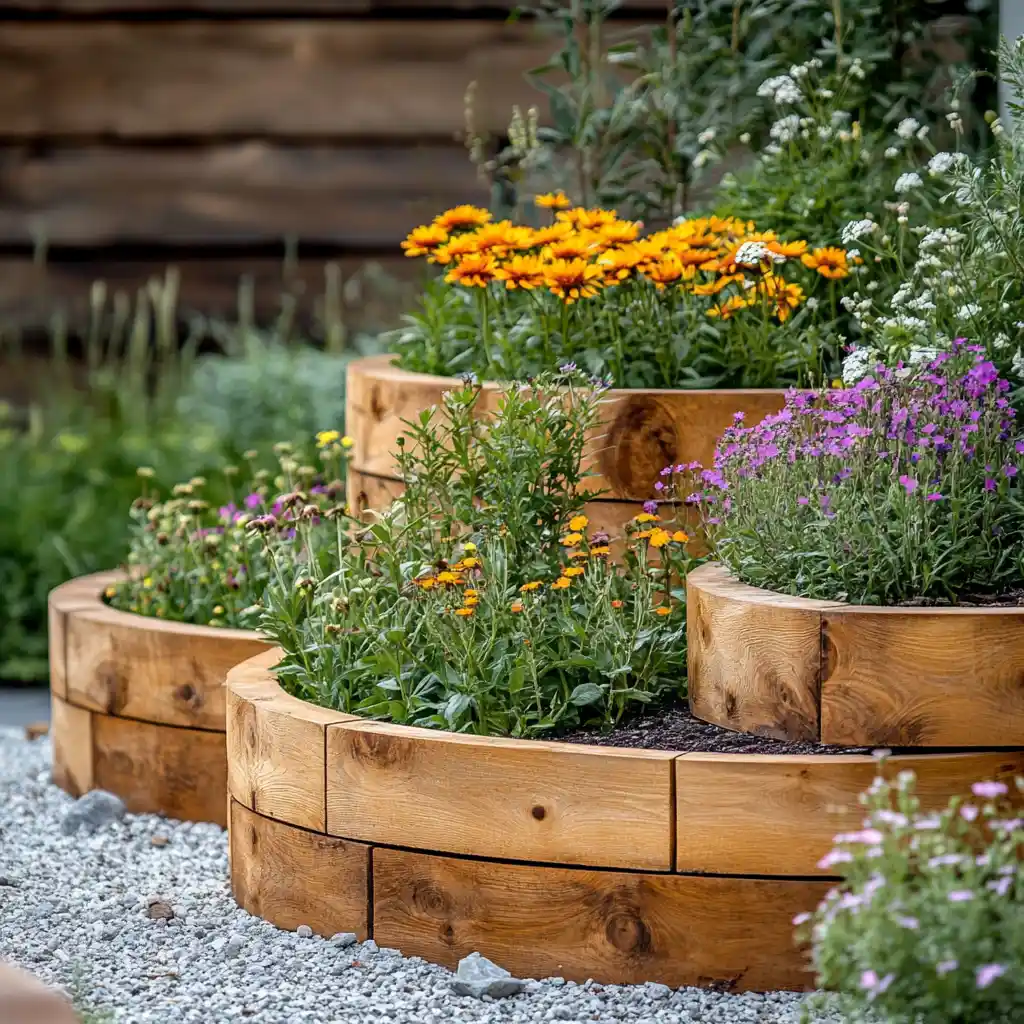
If you want to add height, texture, and drama to your landscape, a tiered flower bed is a perfect solution. By stacking planting areas in layers, you create a dynamic focal point that’s both space-efficient and visually appealing.
Design elements to consider:
- Build your tiers with wooden frames, retaining wall blocks, or metal garden rings.
- Shape options include semicircles, spirals, or even stair-step designs depending on your yard’s layout.
Planting strategy:
- Place tall plants like foxglove, ornamental grasses, or hollyhocks at the top.
- Use medium-height flowers like salvia or geraniums in the middle.
- Fill the front tier with low-growing blooms such as alyssum, marigolds, or creeping phlox.
Not only does this flower bed style showcase a wider range of plants, but it also helps with drainage and organization—especially in sloped or uneven spaces.
6. Tree Base Flower Bed

Transform the bare soil around your front yard trees into a lush and lively flower bed. This idea makes use of underutilized space while adding color and texture beneath existing tree canopies.
Smart planting tips:
- Choose shade-tolerant plants such as hostas, impatiens, astilbe, or vinca minor.
- Use a radial layout: arrange plants in concentric circles to mirror the tree’s canopy and create visual harmony.
- Avoid disturbing tree roots—plant shallowly and use mulch to retain moisture.
Design enhancements:
- Add a stone or wood border to define the space and prevent grass encroachment.
- Include a few decorative accents like solar lights or garden figurines for added charm.
This style of flower bed is low-maintenance and a great way to soften the transition between tree trunks and turf.
7. Vibrant Hanging Flower Bed
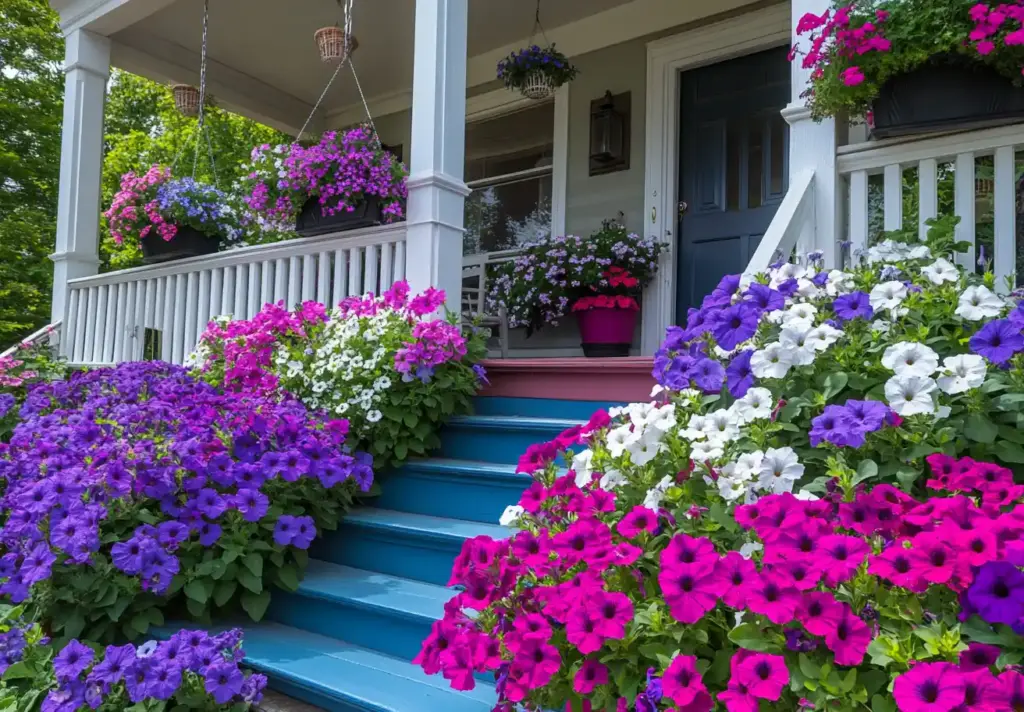
Bring vertical interest and colorful charm to your front yard with a vibrant hanging flower bed. This design is perfect for porches, pergolas, trellises, or even sturdy tree branches—anywhere you can hang a basket or container.
To create an eye-catching display:
- Use trailing flowers like petunias, verbena, lobelia, or bacopa to spill over the edges.
- Add foliage plants like ivy, ferns, or sweet potato vine for contrast and texture.
- Don’t forget culinary herbs like thyme, mint, or basil—beautiful and practical!
Arrangement tips:
- Vary the heights and spacing of baskets for a more dynamic and layered appearance.
- Coordinate flower colors with your home’s exterior for a cohesive look.
This elevated flower bed concept is especially effective in small yards or entryways where ground space is limited but visual impact is still desired.
8. Potted Flower Bed

A potted flower bed is the ultimate in flexibility—perfect for renters, small-space gardeners, or anyone who loves to rearrange their garden layout with the seasons. By grouping containers together, you create a cohesive, portable display that can brighten patios, porches, and walkways.
Design ideas:
- Mix pot sizes and shapes for a natural, layered effect.
- Use pots made of terracotta, ceramic, wood, or even upcycled materials like metal buckets or crates.
- Position taller pots or plants in the back, and smaller ones toward the front.
Planting tips:
- Group flowers with similar light and watering needs.
- Combine thrillers (focal plants like geraniums), fillers (bushy plants like coleus), and spillers (trailing plants like sweet alyssum) for maximum visual appeal.
- Rotate pots seasonally to keep your flower bed fresh year-round.
Bonus: Potted arrangements make it easy to protect delicate plants during extreme weather—just move them indoors or into the shade.
9. River Rock Flower Bed
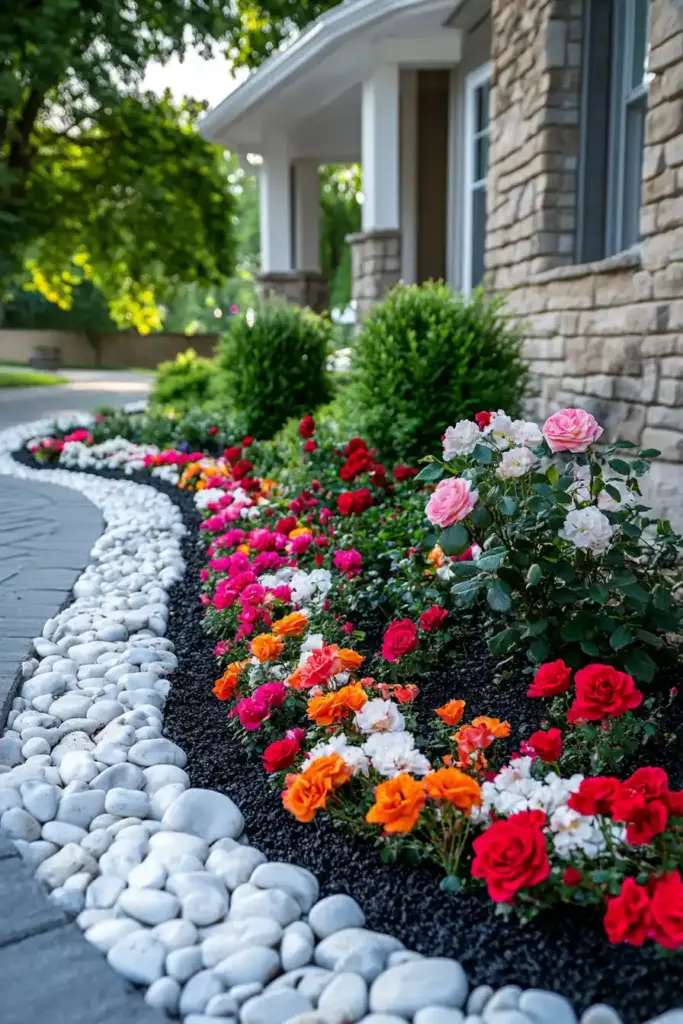
For a modern, low-maintenance twist on traditional gardening, consider a river rock flower bed. The contrast between smooth stones and vibrant blooms creates a textured, polished look that’s both functional and stylish.
How to build it:
- Start by laying landscape fabric over the soil to block weeds.
- Cover the area with river rocks of your choice—gray, white, or multi-toned stones add unique character.
- Cut openings in the fabric to plant drought-tolerant flowers, such as black-eyed Susans, coreopsis, sedum, or lavender.
Design enhancements:
- Use curved edges for a natural feel, or sharp lines for a modern aesthetic.
- Incorporate driftwood, metal garden art, or succulents for an extra pop of style.
This type of flower bed is especially suited for sunny, dry areas and homeowners who want a clean, contemporary look with minimal upkeep.
10. Play with Flower Colors
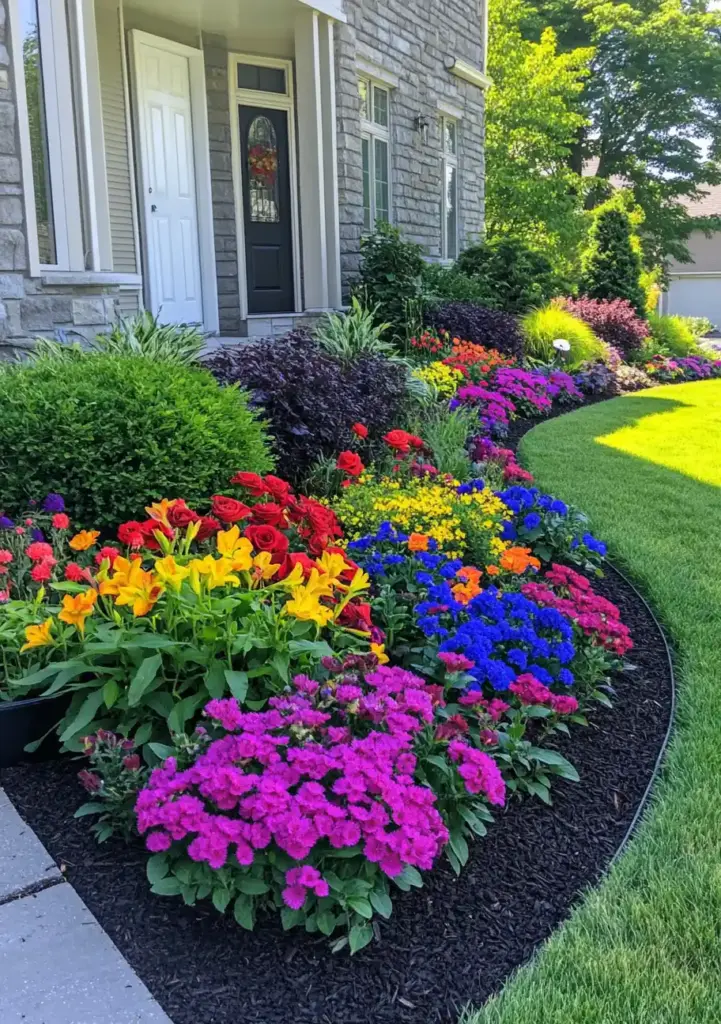
Color is one of the most powerful design tools in your garden arsenal. A thoughtfully colored flower bed can evoke emotion, create harmony, or deliver bold contrast that stops passersby in their tracks.
Color strategy tips:
- Monochromatic schemes (e.g., various shades of pink or purple) feel elegant and cohesive.
- Complementary color pairings—like orange and blue, or purple and yellow—offer high visual impact.
- Analogous palettes (colors next to each other on the wheel, like red-orange-yellow) provide a softer, more natural flow.
Design suggestions:
- Coordinate flower colors with your home’s exterior—soft tones for traditional homes, bolder hues for modern designs.
- Consider seasonal color shifts by planting varieties that bloom in different times of year, maintaining a vibrant flower bed through every season.
Pro tip: Use foliage color—like silver lamb’s ear or burgundy heuchera—to bridge gaps between bloom cycles and add depth to your palette.
11. Log Flower Bed
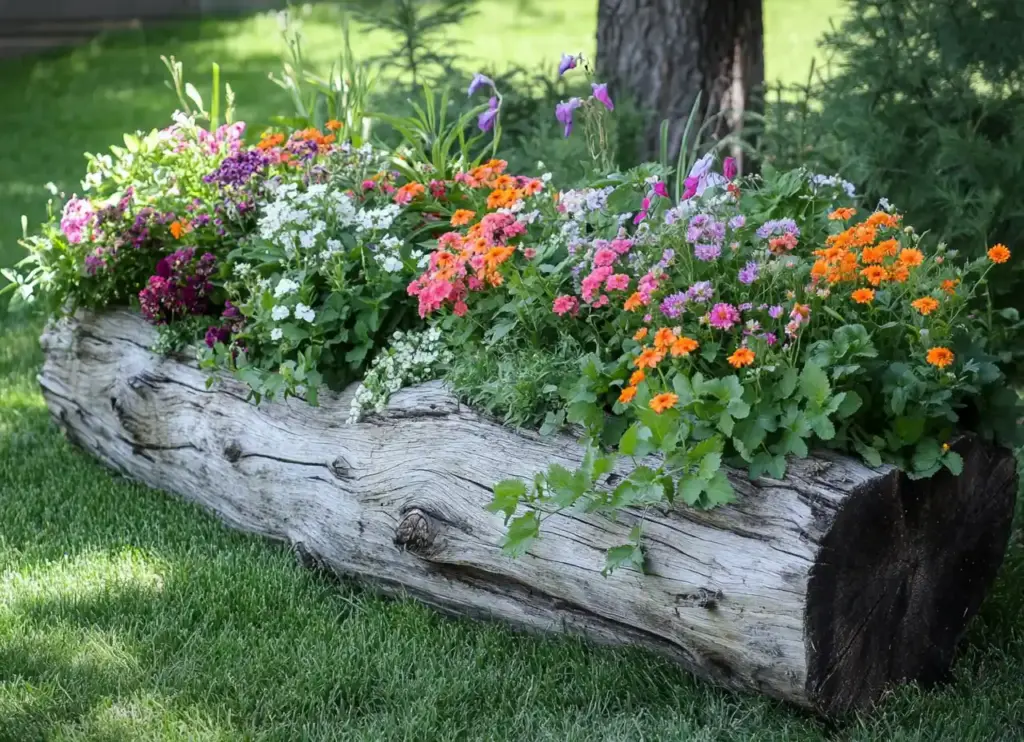
Add rustic charm and eco-friendly flair to your landscape with a log flower bed. Perfect for woodland-style or cottage gardens, this design repurposes natural tree logs as unique, organic planters.
How to create one:
- Select solid, pest-free logs—freshly fallen or reclaimed wood works well.
- Hollow out the center using a chisel or saw, leaving enough depth for potting mix and roots.
- Smooth and seal the inside with a non-toxic wood preservative to prevent decay.
Planting tips:
- Use low-maintenance annuals like pansies, violas, or begonias.
- For a wilder look, add trailing plants like creeping Jenny or lobelia spilling over the sides.
- Place the log near an entry path, porch, or even on a raised base for visibility.
This type of flower bed not only adds visual interest but also tells a story—of reuse, creativity, and natural beauty.
12. Wheelbarrow Flower Bed
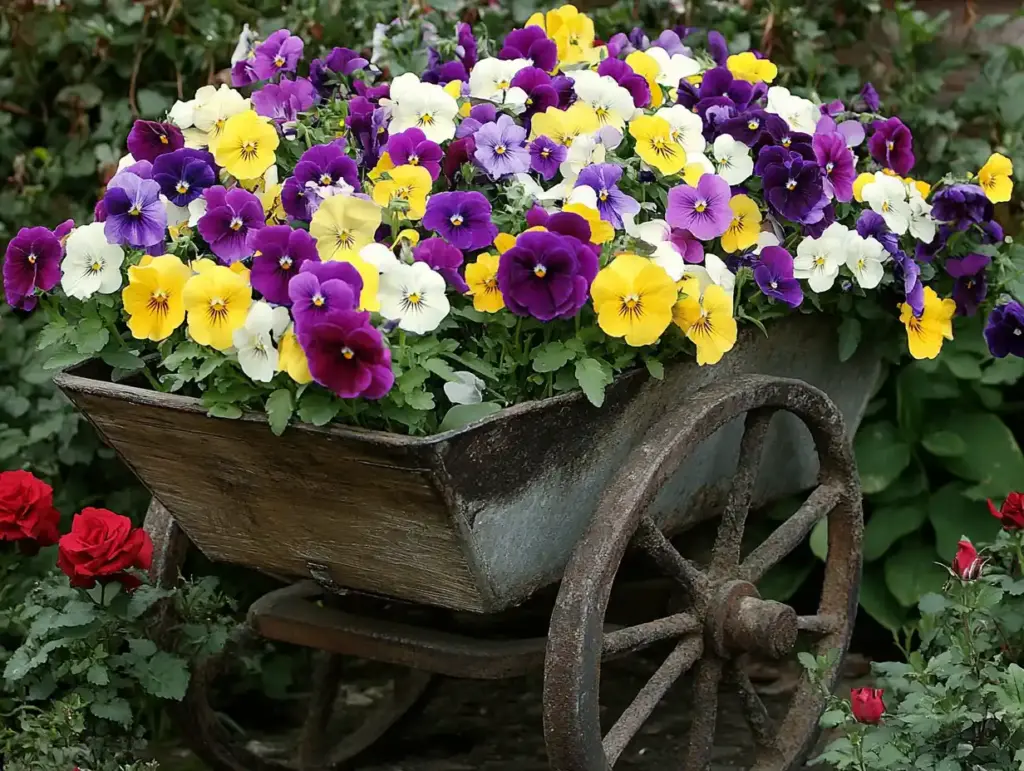
Bring vintage charm to your front yard with a wheelbarrow flower bed—a playful and eye-catching way to showcase your blooms. Whether it’s an old metal barrow or a rustic wooden one, this repurposed planter adds personality and whimsy to any garden space.
Steps to set it up:
- Clean and seal the wheelbarrow to prevent rust or rot.
- Drill drainage holes at the bottom to keep roots healthy.
- Fill with quality potting mix and choose compact or trailing plants for the best effect.
Planting ideas:
- Go bold with petunias, snapdragons, or marigolds for vibrant color.
- Add vines like nasturtium or trailing ivy for a spillover effect.
- Try layering plants of different heights and textures for depth.
The best part? This flower bed is portable! You can reposition it to catch more sun, highlight seasonal displays, or simply change your front yard’s look whenever inspiration strikes.
13. Repurposed Tire Flower Bed
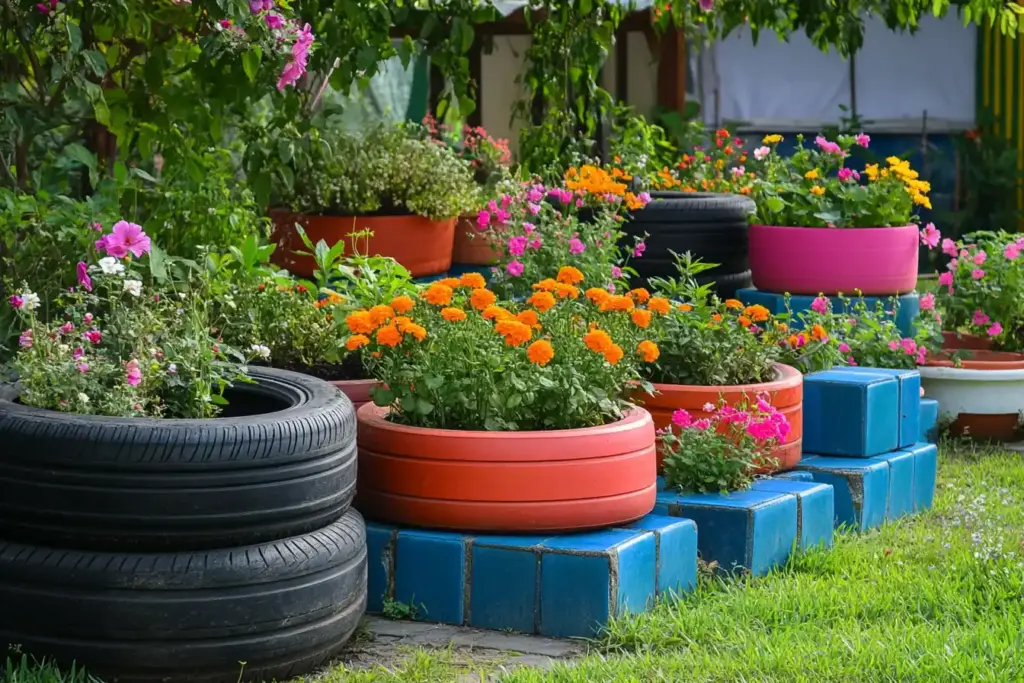
Give old tires a second life by turning them into a bold and eco-friendly flower bed. This upcycled idea adds playful flair to your garden while keeping waste out of landfills—style meets sustainability.
Creative ways to use tires:
- Paint them in bright, weather-resistant colors or patterns to add visual pop.
- Stack multiple tires to create height or hang a single tire on a wall or fence for a vertical planter.
- Cut and shape tires into planters with unique contours or decorative edges.
Planting suggestions:
- Use colorful annuals like zinnias, calendula, or impatiens for a vibrant burst.
- For hanging tire beds, choose trailing plants like sweet alyssum or lobelia.
- Combine tires of different sizes to form a playful arrangement in your front yard.
A repurposed tire flower bed works great in family-friendly spaces or modern eclectic gardens, and it makes a fun weekend DIY project.
14. Wavy Flower Bed
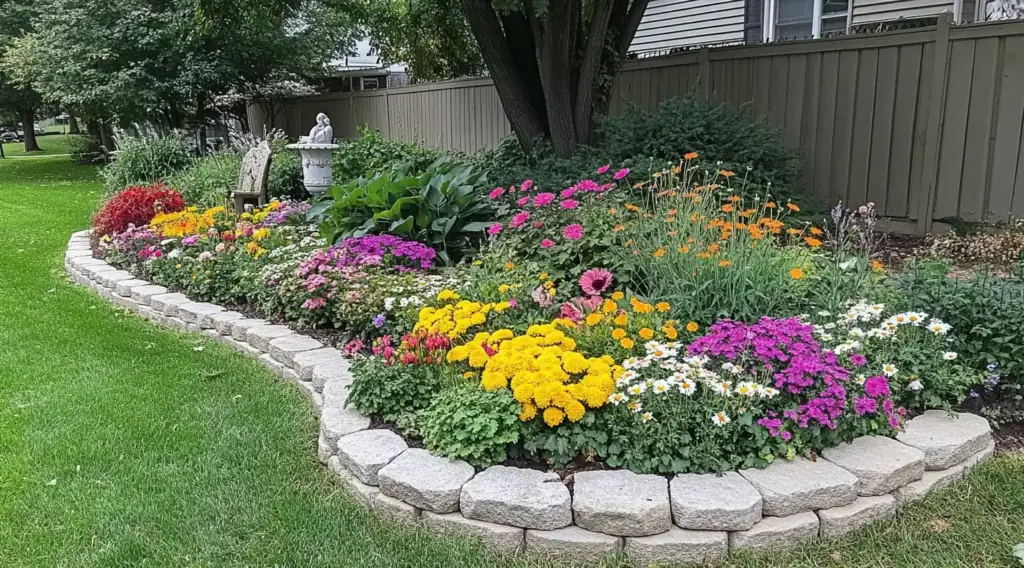
Break free from straight lines and sharp angles with a wavy flower bed—a design that mimics nature’s gentle curves for a more organic and flowing look. This layout adds movement and softness to your front yard, making it feel more welcoming and less formal.
Design tips:
- Outline your bed with a garden hose or rope first to visualize the curves before digging.
- Use natural edging materials like river stones, scalloped bricks, or low boxwood hedges to define the shape.
- Curved beds work best when set against open lawns or along house foundations, driveways, or fences.
Planting strategy:
- Alternate plant heights along the curves to emphasize the undulating lines.
- Choose perennials and shrubs that offer long-lasting color and seasonal interest.
- Incorporate ornamental grasses to add texture and movement with the wind.
Though it requires slightly more maintenance than a straight-edged layout, a wavy flower bed adds elegance and a freeform feel that’s worth the effort.
15. Seasonal Flower Bed Rotation
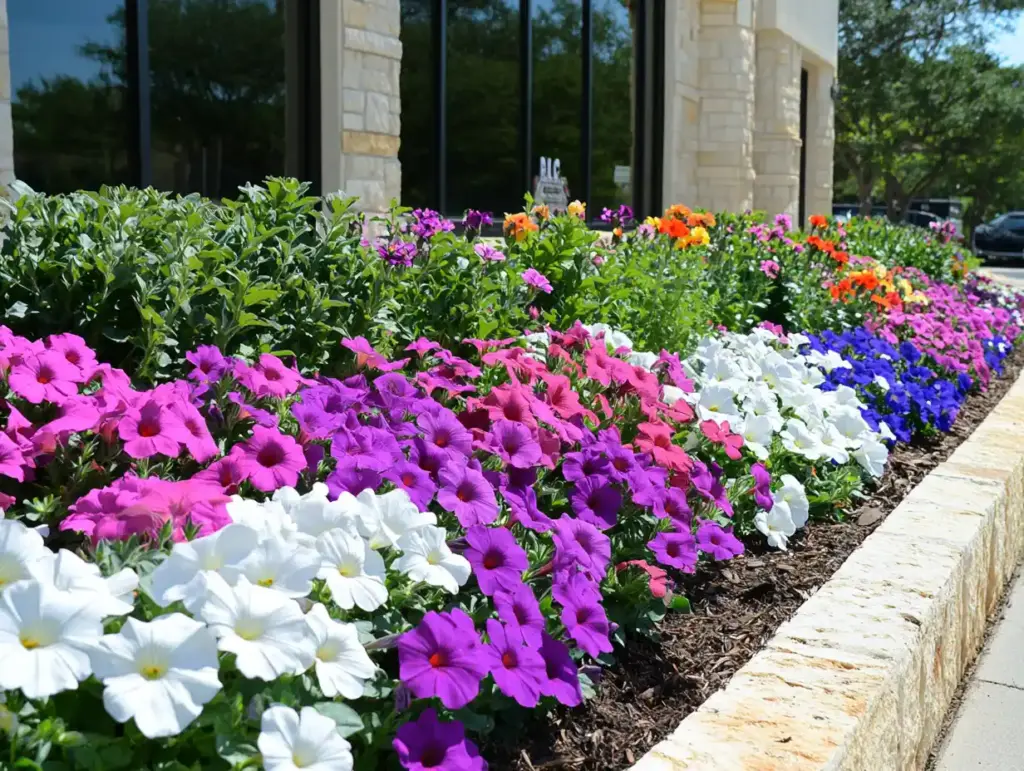
Keep your front yard looking fresh and vibrant year-round with a seasonal flower bed rotation. By planning your planting calendar around bloom times, you’ll ensure there’s always something colorful and eye-catching in your garden.
Here’s a simple seasonal planting guide:
- Spring: Start with bulbs like tulips, daffodils, and hyacinths, and layer in cool-season annuals like pansies and violas.
- Summer: Replace spring blooms with heat-loving plants such as coneflowers, zinnias, salvia, and marigolds for long-lasting color.
- Fall: Transition to warm-toned plants like asters, sedum, and ornamental kale or chrysanthemums.
- Winter: Use evergreen shrubs, decorative grasses, and cold-hardy bloomers like hellebores, witch hazel, or winter jasmine.
Tips for success:
- Choose plants with staggered bloom times to avoid gaps.
- Mix in evergreens and ornamental foliage to keep structure in winter.
- Refresh soil between rotations and apply mulch to retain moisture and prevent weeds.
This rotating flower bed approach ensures visual interest in every season and gives your garden a dynamic, ever-evolving personality.
Frequently Asked Questions (FAQ)
1. What is the easiest flower bed to maintain?
Raised or potted flower beds are among the easiest to maintain. They offer better soil control, improved drainage, and easier access for watering and weeding—ideal for beginners or busy gardeners.
2. How do I choose plants for my front yard flower bed?
Start by considering your climate, sunlight exposure, and soil type. Opt for low-maintenance, native plants that thrive in your region. For year-round color, mix perennials with seasonal annuals.
3. How can I make my flower bed look fuller?
Use the “thriller, filler, spiller” method:
- Thriller: Tall, attention-grabbing plants (e.g. salvia)
- Filler: Bushy mid-height plants (e.g. coleus)
- Spiller: Trailing plants (e.g. sweet alyssum) that drape over edges
Also, plant in odd-numbered groupings and stagger heights for visual depth.
4. How often should I water a flower bed?
It depends on your plant selection and climate. In general:
- Newly planted beds: Water 2–3 times per week
- Established beds: Water once per week deeply
Use mulch to retain moisture and reduce watering frequency.
5. Can I mix vegetables or herbs into a flower bed?
Absolutely! Many herbs like basil, thyme, and chives blend well with flowers and even help repel pests. Just ensure their sunlight and watering needs align with the surrounding blooms.
Conclusion
Creating a front yard flower bed doesn’t have to be overwhelming or expensive. With a touch of creativity, you can transform any area—from a slim walkway flower bed to a shaded tree base—into a vibrant, eye-catching focal point that boosts curb appeal and sets a welcoming tone. Whether you’re working with a compact space or a sprawling lawn, a thoughtfully designed flower bed can make all the difference.
Consider exploring unique layouts like a raised flower bed with seating, or add whimsy with repurposed items like a wheelbarrow or tire. If you’re drawn to softer lines, a wavy flower bed might be the perfect fit. For additional inspiration, check out our guide to 21 beautiful flower beds in front of house ideas and our curated list of 25 stunning full sun flower bed ideas.
As you design your ideal flower bed, remember to factor in seasonality, color coordination, and vertical layering to maximize visual interest. With the right balance of structure and spontaneity, your flower bed will bloom beautifully all year long—reflecting your personality and enhancing your home’s character.
Your dream flower bed is just a shovel (and a little inspiration) away!

